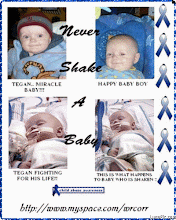By Vanessa Rasmussen, © 2004, All rights reserved. Website: http://www.startingadaycarecenter.com Shaken baby syndrome (SBS) is often known as abusive head trauma, shaken brain trauma, pediatric traumatic brain injury, whiplash shaken infant syndrome and shaken impact syndrome. Shaken Baby Syndrome is the leading cause of death in child abuse cases in the United States. It is caused by vigorous shaking of an infant or young child by the arms, legs, chest or shoulders. In some cases, the shaking is accompanied by a final impact to the baby's head against a bed, chair, or other surface. Forceful shaking can result in brain damage leading to mental retardation, speech and learning disabilities, paralysis, seizures, hearing loss and even death. It may cause bleeding around the brain and eyes, resulting in blindness. The degree of brain damage depends on the amount and duration of the shaking and the forces involved in impact of the head. When a baby is vigorously shaken, the head moves back and forth. This sudden whiplash motion can cause bleeding inside the head and increased pressure on the brain, causing the brain to pull apart and resulting in injury to the baby. A baby's head and neck are especially vulnerable to injury as the head is large and the neck muscles are still weak. In addition, the baby's brain and blood vessels are very fragile and easily damaged by motions, such as shaking, jerking and jolting. SBS occurs most frequently in infants younger than six months old. The number one reason a baby is shaken is because the child just won't stop crying. Often frustrated parents or other persons responsible for a child's care feel that shaking a baby is a safe way to make a child stop crying. Almost 25 percent of all babies with SBS die. Those who do survive suffer from disorders ranging from mild learning disabilities and behavioral changes to moderate and severe repercussions, such as profound mental and developmental retardation, paralysis, blindness, inability to eat or a permanent vegetative state. It is estimated that 25-50 percent of parents and caretakers aren't aware of the effects of shaking a baby. Parents should receive information about shaken baby syndrome prevention in the hospital and/or at their child's two-month immunization appointment. Pediatricians and nurses should talk to parents about their level of stress and how they respond to a crying infant who can not be readily calmed. Parents and other care providers need assurance that allowing a baby to cry is okay if all their needs have been met. Guidance can be given to let parents know that a crying infant should never be shaken and what to do when their frustration is overwhelming. Child caregivers, teenage baby sitters, day care center staff and respite workers should be warned of the dangers of shaking a child. All child care providers should be screened by the parent to determine the potential caregiver's ability to understand infant behavior and how he or she might handle stressful situations, such as incessant crying. Social service agencies, state and national agencies and hospitals need to educate the public about the dangers of SBS. Normal interaction and playing with a child, like bouncing the baby on a knee, tossing the baby in the air (slight danger exists as in the possibility of dropping the baby), riding in a backpack while the parent jogs or bike rides will not cause SBS, although it is important never to shake a baby under any circumstances because gentle shaking can rapidly escalate. Remember a crying baby is not a reflection on your parenting skills and doesn't make you a bad parent. Copyright 2001, 2004. All rights reserved. Any reproduction of this article in whole or in part without written or verbal permission is strictly prohibited. For information about reprinting this article, contact the copyright owner: Vanessa Rasmussen, Ph.D, Starting a Day Care Center, http://www.startingadaycarecenter.com.
Friday, January 16, 2009
Subscribe to:
Post Comments (Atom)














0 comments:
Post a Comment